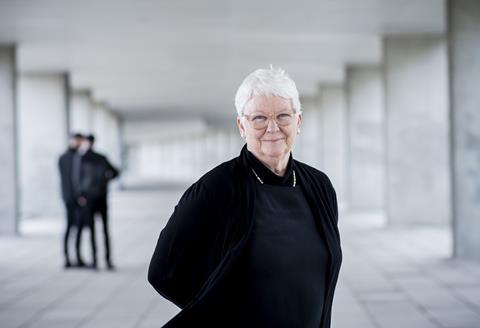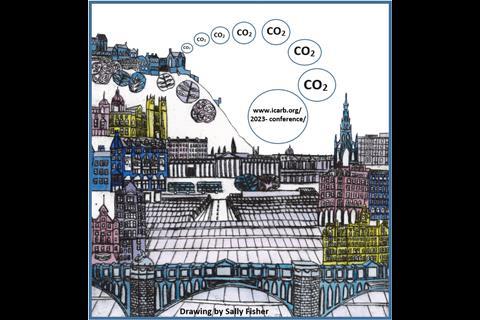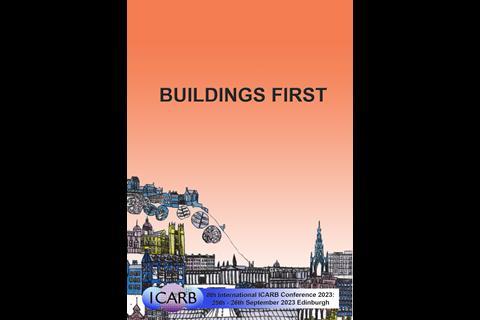With time running out to avert the worst of climate change, approaches to achieving Net Zero need to change fast, writes Susan Roaf

Ostrich like, I often stick my head in the sand about things that upset me and I cannot do anything about – like the refugee crisis. But the unavoidable elephant in my mind reminds me that climate change is driving emigration as millions are forced from their heat or flood stricken lands to seek decent lives elsewhere. What we Architects can actually do is something about climate change!
40% of global Greenhouse Gas Emissions (GHG) come from buildings and those emissions are growing annually at alarming rates. We really need to take a short, hard look at where our profession has come from, where we are now, and where we want to be in the future because we, who design buildings, have a vital role to play in reducing global missions and quite simply in saving the world.
Looking back at the data, most emissions come from ‘modern buildings’, not least those energy profligate glass towers so popular (until now?) in westernised cities around the world. Post World War II in the 1950s and 60s, speed of erection was deemed paramount as we rebuilt nations.
Public buildings and offices were thrown up with increasing levels of light-weight glazing and industrialised construction. They were still mostly naturally ventilated and heated until the late 1980s.
After that the requirements for air-conditioning (AC) and mechanical ventilation were skilfully inserted into the regulations by the very Heating, Ventilating and Air-Conditioning engineers (HVAC) who not only shaped the regulations, but also make their money putting machines into buildings. They work alongside product suppliers whose fat marketing budgets fund their people on the key committees.
By the 1990s the introduction of HVAC standards had effectively side-line architects’ contributions to designing indoor building performance conditions. This was achieved by using devices like the pseudo-precision of proscriptively mandated and unchallenged indoor air-flow rates, carbon dioxide levels, humidity and temperatures to levels that could only be theoretically ‘guaranteed’ with machines and air-blown, ducted, delivery systems. Job done.
We have a small window of opportunity to act to save our species and the planet as well. But who of us sees clearly how best to act?
Those standards were largely based on modelled, or crude and dated laboratory based studies that were un-validated in real buildings, or at worst like the carbon dioxide standards, based on no credible evidence at all. Do architects suffer from a type of Stockholm Syndrome when it comes to engineers?
How many of you will be alarmed when I write that you do not need an extract fan for a bathroom in a well-constructed and designed building with effective opening windows?
The 1992 Rio Conference alerted the world to the need for urgent action to halt runaway climate change. The regulatory response was for more Energy Efficiency.
Those were simpler days where people still understood the need for better buildings as opposed to simply promoting more efficient machines (what comes after heat pumps?). The 1990s Fabric First mantra involved more insulation, better windows, no draughts or cold bridges and of course more gas and electrical efficiency in machines.
By the Naughties Sustainability was all the rage in a nod to the complexity of the resource flows through the built environment. Profitable green rating schemes put simplistic measures for individual issues into rating bags that were shaken up and produced a number out the end stating how ‘sustainable’ a building was.
Light bulbs, bicycle racks, water butts, transport miles and insulation all went into the bags in which the relative usefulness of each factor in saving the planet was decided by experts, who then fiddled about with priority and prejudice-influenced assumptions inside their own black-box protocols.
We largely ended up with ‘developer’s delight’ solutions. Admittedly many designers also better understood that buildings were connected to the world around them, at least theoretically. Light weight, cheap and fast to build archetypes were effectively marketed as ‘green’ and proved very profitable in the rising middle class property markets.
However, many new buildings adhering to the evolving regulations have been riddled with problems like overheating in hot spells, mould, and high energy bills. Conversely at best, and if not of ‘grand design’ proportions or stupidly over-glazed, many new builds can be snug, economical to run and comfortable to live and work in.
By the Teens, extreme weather events alerted us to the need for more radical change. Resilience became the by-word. Awareness grew that Mitigation (reducing emissions) needed to be balanced with Adaptation (the ability of buildings to protect people from weather extremes).
Yet unaccountable councils kept on putting more developments on flood plains while wind speeds increased, rainfall became more unpredictable, extreme temperature records are broken annually, and energy grids consequently regularly fail.
The building standards industry’s response was still - more machines. Fixed window buildings were even allowed in pursuit of that efficiency, even in the face of the COVID pandemic that showed us the most effective way to remove COVID from spaces was to open a window.
Where are we now in the Twenties? Humanity is on a knife edge. We have a small window of opportunity to act to save our species and the planet as well. But who of us sees clearly how best to act?
Not me – which is why we are holding ICARB 2023 to help us grow beyond the shackles of conventional thinking that bind us to existing regulations, standards, rating systems, models and design products developed based on past climates.
At ICARB 2023 experts from many disciplines, from 24 countries, from different professions and industries are coming together to openly deliberate on the fundamentally important questions that underlie current Net Zero aspirations and metrics like:
- Who decides (should and does) what Net Zero Targets are, and are their priorities right?
- What issues will actually matter most for buildings in the very different decades ahead?
- How far can we rely on grid decarbonisation to meet carbon reduction targets in reality?
- How are carbon targets and standards planned, costed and validated?
- What Net Zero Policies actually work in practice in real buildings?
- How much do embodied energy or mechanical efficiency matter in a heating world?
- How do we account for energy sufficiency - things like thermal mass, natural ventilation and shading – without using the simple metrics of mechanical efficiency?
- Are there key things architects can do now to radically cut GHG emissions from buildings?
I do not know what the assembled ICARB 2023 experts will say or advise – but I have an open and eager mind to learn from them.
Almost exactly 60 years ago in 1963, Martin Luther asked in his ‘I have a dream’ speech for radical social change because of the fierce urgency of now. That scale of urgency applies to us architects today because of our role in slashing GHG emissions from buildings.
There is no more time for dreaming. Architects arise! A safer future for humanity in a heating world involves better buildings, not more, or even more efficient machines.
Let Buildings First be our mantra from now on. Let us hope that ICARB 2023 makes a real difference in enabling us all to steer the super-tanker of the built environment towards a safer harbour, because right now we are all sailing very close to the wind, and heading right towards the oncoming storm.
Do you want know about Net Zero?
Join us taking a short, hard look at Net Zero at www.icarb.org/2023-conference/
Postscript
Susan Roaf is emeritus professor of architectural engineering at Heriot Watt University, Edinburgh. She is best known for her work on adapting buildings and cities for climate change. She has written and edited 22 books on sustainable design and climate change adaptation, including Adapting Buildings and Cities for Climate Change, by S Roaf, D Crichton and F Nicol, Routledge, 2009.



















No comments yet